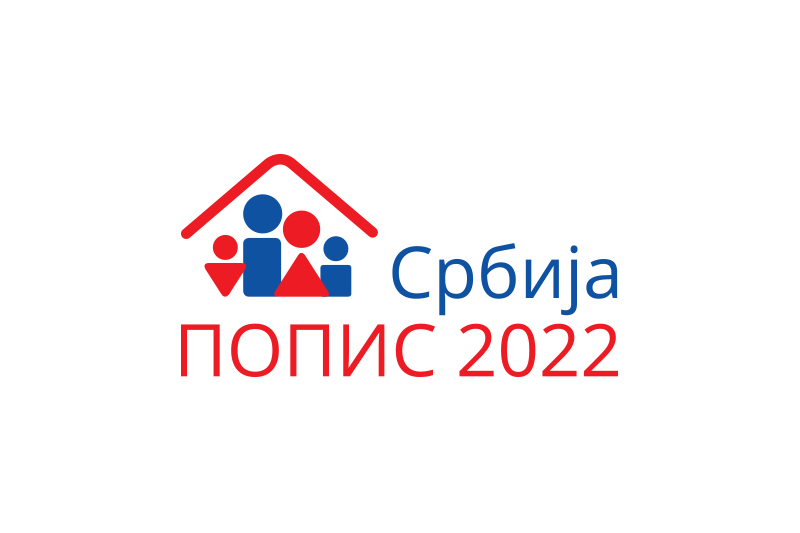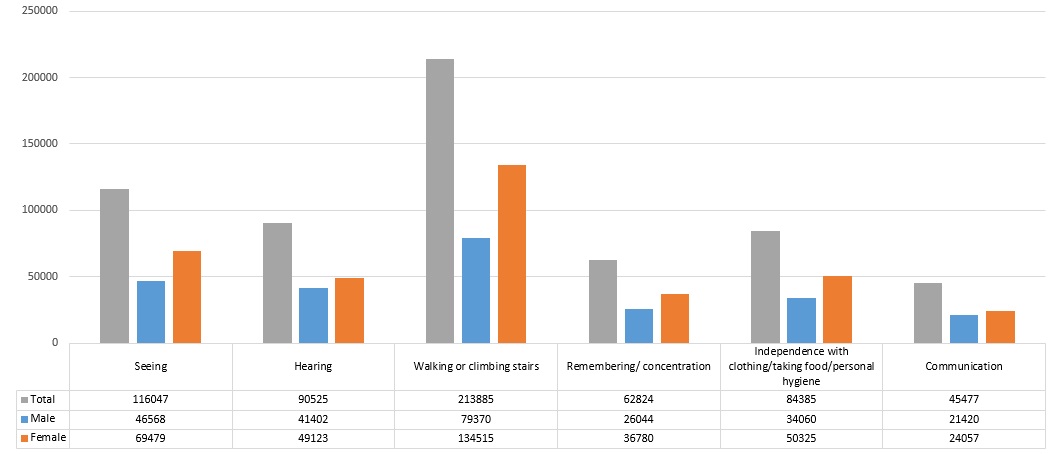
Population according to disability status and type of problem of persons with disabilities
The Statistical Office of the Republic of Serbia publishes the final results of 2022 Census of Population, Households and Dwellings on the population of the Republic of Serbia according to disability status and type of problem of persons with disabilities.
Data are presented by sex and age, up to the level of municipalities and cities.
Data on disability were obtained on the basis of the respondents' answers to questions whether they have difficulties in performing daily activities due to problems with:
- seeing (even provided with glasses),
- hearing (even provided with hearing aid),
- walking or climbing stairs,
- remembering/concentration,
- independence with clothing/taking food/personal hygiene,
- communication (speech, mutual understanding with people and in surrounding).
To each of the six questions asked, the person could declare that: (1) there are no difficulties, (2) there are small difficulties, (3) there are many difficulties, (4) fully disabled in performing daily activities and (5) does not want to reply.
When collecting the data on disability, a sociological approach was used, according to which a person may consider that, despite the existence of a certain health problem, there are no difficulties in performing daily activities at home, at school or at work, thanks to the support of the environment, usage of the appropriate aids, etc.
Questions about disability were not asked for children below the age of two. For children aged two to four, questions were asked only about seeing, hearing and walking, while for persons aged five and above, whole question are posed.
The contingent of persons with disabilities includes all persons aged two and over who, due to at least one of the mentioned problems, have many difficulties or are fully disabled in performing daily activities - a total of 356 404 persons (148 104 men and 208 300 women).
Persons without disabilities are persons for whom the answer to each of the questions was received that they have no difficulties or that they have small difficulties - a total of 6 060 960 persons (2 963 556 men and 3 097 404 women), while persons who did not want to answer to none of the questions and persons for whom data was not collected, included are in the contingent of persons whose disability status is unknown - a total of 109 343 persons (58 475 men and 50 868 women).
Table 1: Population aged two and over according to disability status, by region
| Total | Persons with disabilities | Persons without disabilities | Persons whose disability status is unknown | ||||
| all | % | all | % | all | % | ||
| REPUBLIC OF SERBIA | 6 526 707 | 356 404 | 5,46 | 6 060 960 | 92,86 | 109 343 | 1,68 |
| Beogradski region | 1 648 978 | 68 280 | 4,14 | 1 534 931 | 93,08 | 45 767 | 2,78 |
| Region Vojvodine | 1 707 502 | 107 094 | 6,27 | 1 578 876 | 92,47 | 21 532 | 1,26 |
| Region Šumadije i Zapadne Srbije | 1 787 518 | 93 785 | 5,25 | 1 669 251 | 93,38 | 24 482 | 1,37 |
| Region Južne i Istočne Srbije | 1 382 709 | 87 245 | 6,31 | 1 277 902 | 92,42 | 17 562 | 1,27 |
| Region Kosovo i Metohija* | … | … | … | … | … | … | … |
* 2022 Census was not conducted on the territory of AP Kosovo and Metohija
The highest participation of persons with disabilities in the total population aged two and over was recorded in the municipalities: Crna Trava (14.0%), Plandište (13.6%), Gadžin Han (10.4%) and Svrljig (10.0%). ), while the lowest participation of persons with disabilities was recorded in the municipalities: Preševo (1.1%), Tutin (1.9%), Novi Pazar (2.1%) and Bujanovac (2.4%). Note: The share of persons with disabilities in municipalities/cities where there are institutions for their permanent accommodation may be increased, which is especially obvious in the municipalities with a small number of inhabitants. In the contingent of people with disabilities (356 404), the most people have problems with walking (60%), while the smallest share of people have problems related to communication (12.8%).
Graph 1: Persons with disabilities aged two and over by type of problem and sex

Note: The sum of the columns in the table does not provide the total number of persons with disabilities, given that one person may have difficulties in performing daily activities due to two or more different problems.
Population aged two and over by disability status, sex and age
Persons with disabilities aged two and over by type of problem, sex and age
- 26.04.2024. Households by the family composition and characteristics of the reference person
- 08.03.2024. The most frequent names and surnames
- 23.02.2024. Comparative overview of the number of dwellings
- 23.02.2024. Comparative overview of the number of population and households by censuses 1948–2022
- 28.12.2023. Households and Dwellings on the number of dwellings by type of buildings, year of construction and floor
- 22.12.2023. Population by individual age and by school attendance
- 01.12.2023. Population according to disability status and type of problem of persons with disabilities
- 17.11.2023. Population by economic activity
- 15.11.2023. Heating in occupied dwellings without central heating
- 20.10.2023. Families
- 12.10.2023. Installations in dwellings
- 29.09.2023. Migrations
- 25.08.2023. Marital Status and Fertility
- 24.08.2023. The number of dwellings in the Republic of Serbia according to occupant density, ownership and occupancy status
- 31.07.2023. Educational attainment, literacy and computer literacy
- 20.07.2023. Number of persons and households in dwellings and occupied premises
- 07.07.2023. Households according to the number of members
- 16.06.2023. Мother tongue, religion and ethnic affiliation
- 08.06.2023. Rooms and Auxiliary Premises in Dwelling
- 25.05.2023. Age and Sex
- 18.05.2023. Number and floor space of housing units
- 28.04.2023. Final results - Ethnicity
- 21.12.2022. First results of the 2022 Census of Population, Households and Dwellings
- 21.12.2022. Press conference - The first results of 2022 Census of Population, Households and Dwellings
- 01.12.2022. Tomorrow, December 2, 2022, the enumerators are back on the field
- 08.11.2022. TELEPHONE NUMBERS OF ON-DUTY ENSUMERS BY MUNICIPALITIES AND CITIES
- 07.11.2022. Today, November 7, 2022, at 8 p.m., field data collection in the 2022 Census ends
- 31.10.2022. CENSUS 2022 is entering the final phase of implementation on the ground
- 25.10.2022. Meeting with the High Commissioner on National Minorities of the Organisation for Security and Cooperation
- 21.10.2022. In 20 days, more than 4.7 million citizens have been enumerated in 2022 Census
- 07.10.2022. In six days, more than 1,350,000 inhabitants have been enumerated.
- 30.09.2022. 2022 Census of Population, Households and Dwellings begins
- 26.09.2022. Workshop on Census
- 20.09.2022. Final list of selected enumerators
- 16.09.2022. Census info-center 2022 has started working
- 08.09.2022. Meeting of the representatives of the Embassy of Great Britain
- 01.09.2022. Training of enumerator candidates
- 26.08.2022. Final list of candidates for enumerators invited for training
- 20.08.2022. Preliminary list of candidates for enumerators invited for training
- 18.08.2022. Information workshops for members of national councils of national minorities on the occasion of the upcoming Census
- 12.08.2022. The final list of selected instructors
- 10.08.2022. Ranking list of registered candidates for enumerators
- 08.08.2022. Ranking lists of registered enumerator candidates are published on August 10
- 22.07.2022. Public call for registering enumerators
- 22.07.2022. Final list of instructor candidates invited for training
- 21.07.2022. The final list of candidates for IT assistants who passed the 2nd round of the public call
- 19.07.2022. Media conference on the occasion of 2022 Census of Population, Households and Dwellings in the Republic of Serbia
- 15.07.2022. Announcement of public call for enumerators
- 13.07.2022. Preliminary list of candidates for IT assistants, second round
- 06.07.2022. Ranking list of candidates for instructors in the Census 2022 who are invited to submit documentation, test and interview
- 05.07.2022. List of registered candidates for work as an IT assistant, second round
- 29.06.2022. The second public call for applicants to work as an IT assistant
- 28.06.2022. Final list of candidates for IT assistants
- 24.06.2022. Public call for candidates for instructors in the 2022 Census
- 22.06.2022. Preliminary list of candidates for IT assistants
- 21.06.2022. Training of municipal and regional coordinators
- 17.06.2022. About 2,500 instructors will be needed to conduct the 2022 Census in the Republic of Serbia
- 14.06.2022. List of registered candidates for work as an IT assistant
- 08.04.2021. Field implementation of the Census from October 1st to October 31st, 2022
LATEST NEWS
Share this page |
|
|





